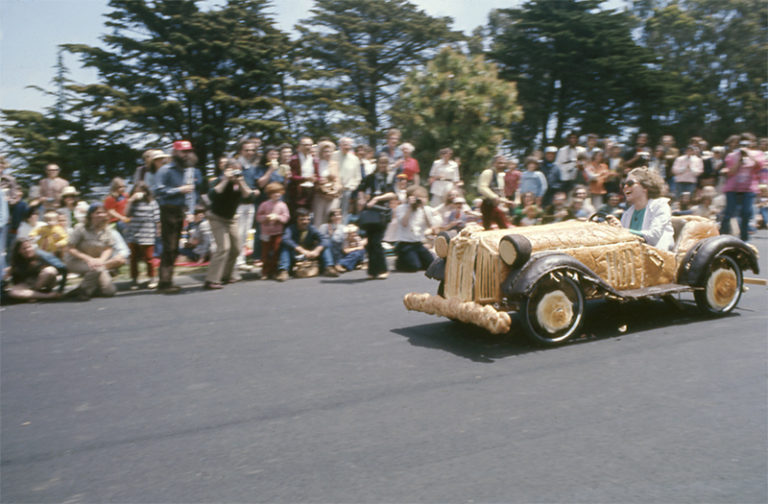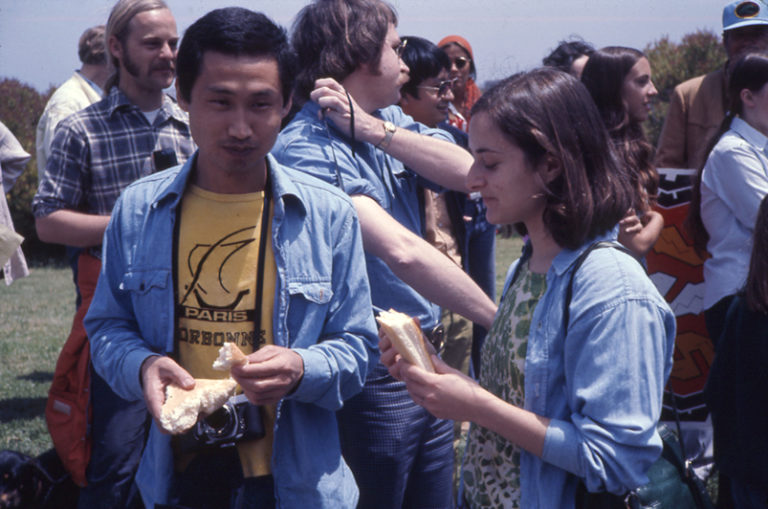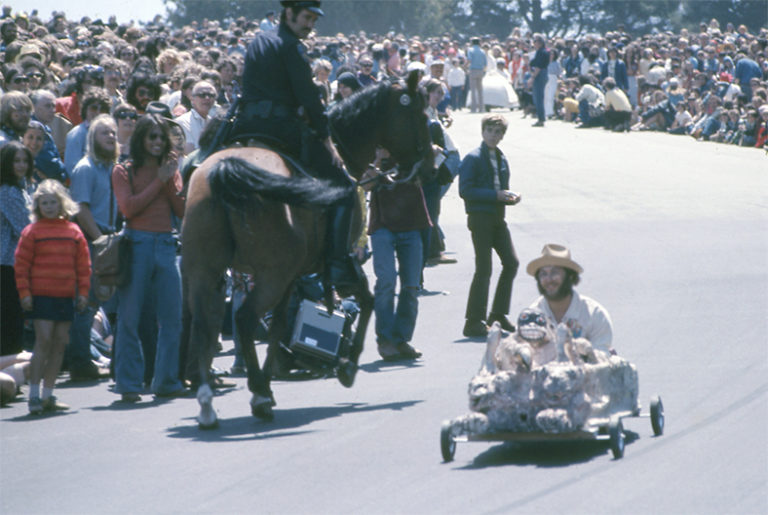
Catherine Theilen Burke was a student at San Francisco’s Lowell High School when she attended SFMOMA’s inaugural derby race, back on a sunny day in May 1975. She looks back on her experience as a teenage spectator with great fondness. “I remember the excitement and the surprise of each car. I never felt danger like they were going to crash; it was just wild and crazy and exciting,” she says. “People were so into it.” When Theilen Burke arrives at the museum’s revival derby event on April 10, 2022, it will be as a racer, driving a phoenix-themed car she is building with the art students she now teaches at Lowell.
The educator, one of more than fifty artists, organizations, and crews racing this year, finds herself mostly concerned with the pitch of the terrain. “It’s a steep, fast hill,” she says of McLaren Park’s Shelley Drive, where all of the museum derbies have taken place. “My strategy is to go as slow as possible. I went down it on my bike to test it out.” The avid cyclist found bicycling her happiest mode of facilitating distance learning during the COVID-19 pandemic. “I got my students’ addresses and biked their neighborhoods. I took pictures of storefronts and street art, things I knew they would recognize. The whole city is a museum. Wherever you are, whatever they’re looking at, that’s art.”
Artist Chip Lord drove one of the cars that made quite a scene down Shelley Drive’s curving, 800-foot hill, back in 1975. He was a member of the now-legendary Ant Farm collective at the time. When he returns this year to design a trophy, it will be as an SFMOMA collection artist and a professor emeritus at UC Santa Cruz. Thinking back to his experience, Lord has memories of feeling not yet accomplished enough to participate. “I knew some of the artists at the time, but I felt like a total outsider,” says Lord. “I didn’t go to the Art Institute or CCA, so I felt like I was outside these networks. I don’t remember too much about the race itself, but I remember before we all wandered around in the pits, getting a look at each others’ work.”
Lord recalls one thing from the 1975 race ruefully. “My brake was just a piece of wood that scraped against the ground. This time, I’m happy to be making a trophy instead of racing.” Lord’s trophy-in-progress, to be awarded to the “best engineered” vehicle, is based on a vintage model kit of a dark red 1932 Ford Roadster hot rod.
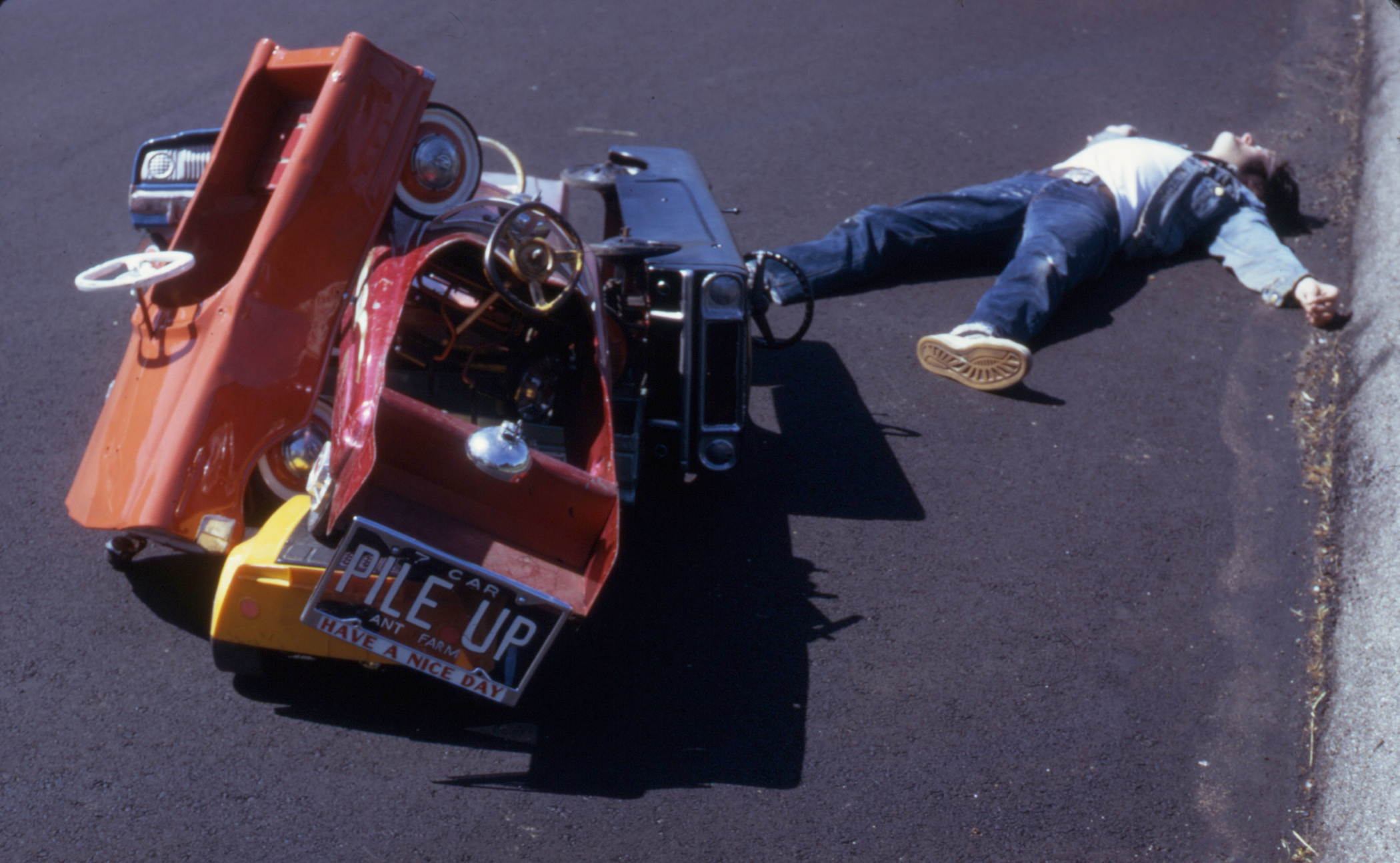
Chip Lord in the First Artists’ Soap Box Derby, 1975; SFMOMA Archives
In hopes of winning that trophy, derby alumnus Ron Covell is constructing a racer from fourteen-feet-long flexible steel tubing. The ride is inspired by the derby car he helped build with his instructor, the late Don Potts, while Covell was a college student a San Jose State University in 1975. Covell will be suspended inside his creation with his nose down, a mere six inches from the ground. “At that height,” Covell says, “ten miles an hour feels like eighty. Like riding a wet noodle down a greased slope.”
He recalled the three-wheeled outrigger he built with Potts having some mechanical problems.
“Potts wanted the wheels to lean together when it cornered. We finished it a few weeks ahead of time and took it out to McLaren Park to try it. [Potts] hung on his side by three belts, enclosed in a tube that was hinged out, and then screwed back into place. During the test, the car tipped on its side at the left-hand turn at the base of the hill. The outrigger meant it made good right-hand turns, but bad left-hand turns. Took us two weeks to fix it, by hanging a lead weight on the outrigger wheel. On the day of the race, we were very anxious and there was a huge crowd. Don went fast and the car made the corner just lickety-split. And what an experience that was for his students, to have put that thing together!”
Covell, who, like Theilen Burke, entered the museum’s Open Call, has participated in all three of the museum derbies. He cruised his own racer down the track at the oft-overlooked second derby, in 1978. Covell has spent the intervening decades making art and teaching; his latest endeavor is sharing creative metalworking tutorials with nearly 200,000 subscribers on his YouTube channel. Covell did not mince words about what his first entry with Potts meant to him. “It was a highlight of my artistic career, letting me rub elbows with other artists who were making vehicles,” he says. “I was an art student: nobody knew who I was and that got my career off to a booming start.”
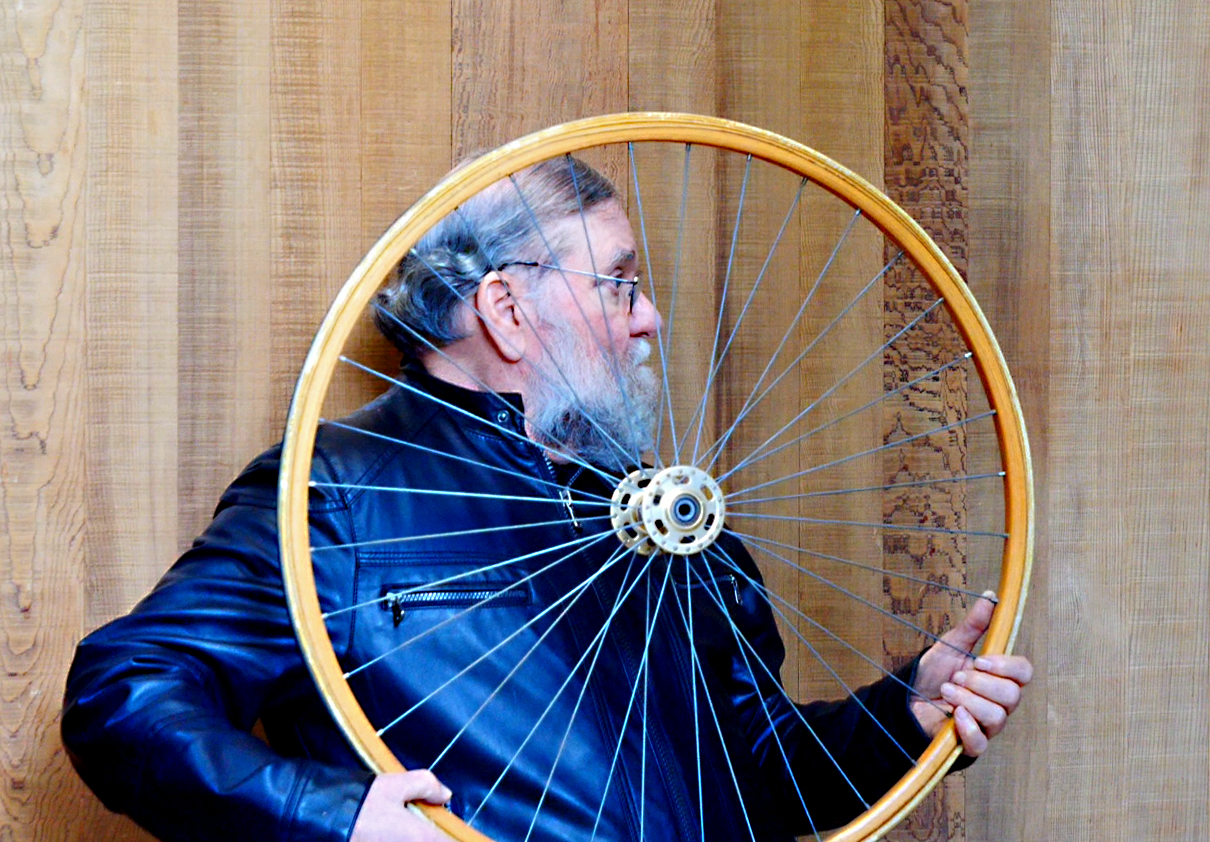 Photo courtesy Ron Covell
Photo courtesy Ron Covell
Former racer Dorcas Moulton, tasked this year with dolling out the trophies as a judge, expressed similar sentiments. In her mind, as in others, the original derby is akin to “pre-Burning Man” performance art. “That wasn’t our intention at the time, we were just having fun. We had no idea we were creating history,” Moulton says.
She enlisted the help of a now-shuttered bakery to make the breaded body panels of her Moulton’s Edible Special, a derby car that participants and spectators shared after the race. The ride won the title of “Most Endearing” and a trophy designed by Ruth Asawa, whose participation inspired some racers to join up this year. Record of the car’s creation, cruise, and devouring appears in filmmaker Amanda Pope’s documentary of the 1975 event.
Pope, too, is returning to judge alongside Moulton, making the trek from the University of Southern California, where she teaches film. Back in 1975, she was living in San Francisco and had heard about the Soapbox Derby from her friend, the late Orian Taylor. Pope decided to film the affair and recalls being on a “mission to get a shot of every car.” The shoot marked her first major solo undertaking. “I had worked on big productions where I was an associate producer, but to have a film that you’ve generated on the most modest means? It was offered as a short film by this company called Learning Corporation. . . it was a big deal for me.” Pope has since given the film to SFMOMA for free streaming.
Asked about the cars that she remembers most vividly, Pope is quick to rattle off a list of names including “Potts” and “Dorcas,” at one point saying, “you have to get ahold of one of Potts’ students — they have to be involved.” The first name she cites, however, is “Richard Shaw” and the iconic Tuxedo Racing Pencil the acclaimed ceramicist designed with Gregor Weiss and Steve Wall. “Oh, well, that was just such a beautifully designed car,” Pope says, matter-of-factly.
Come April 10, the pencil and team Shaw Weiss are racing with a new generation. “We are rebuilding the original car,” Shaw says. “It’s been under a porch in Santa Rosa at Gregor’s house all this time, but it looks pretty good. He’s doing a great job, and he should get all the credit for that. But my daughter and her husband are building a car. I just loved—back then—to see how creative and unusual all the cars were. I’m so excited to see it again.”
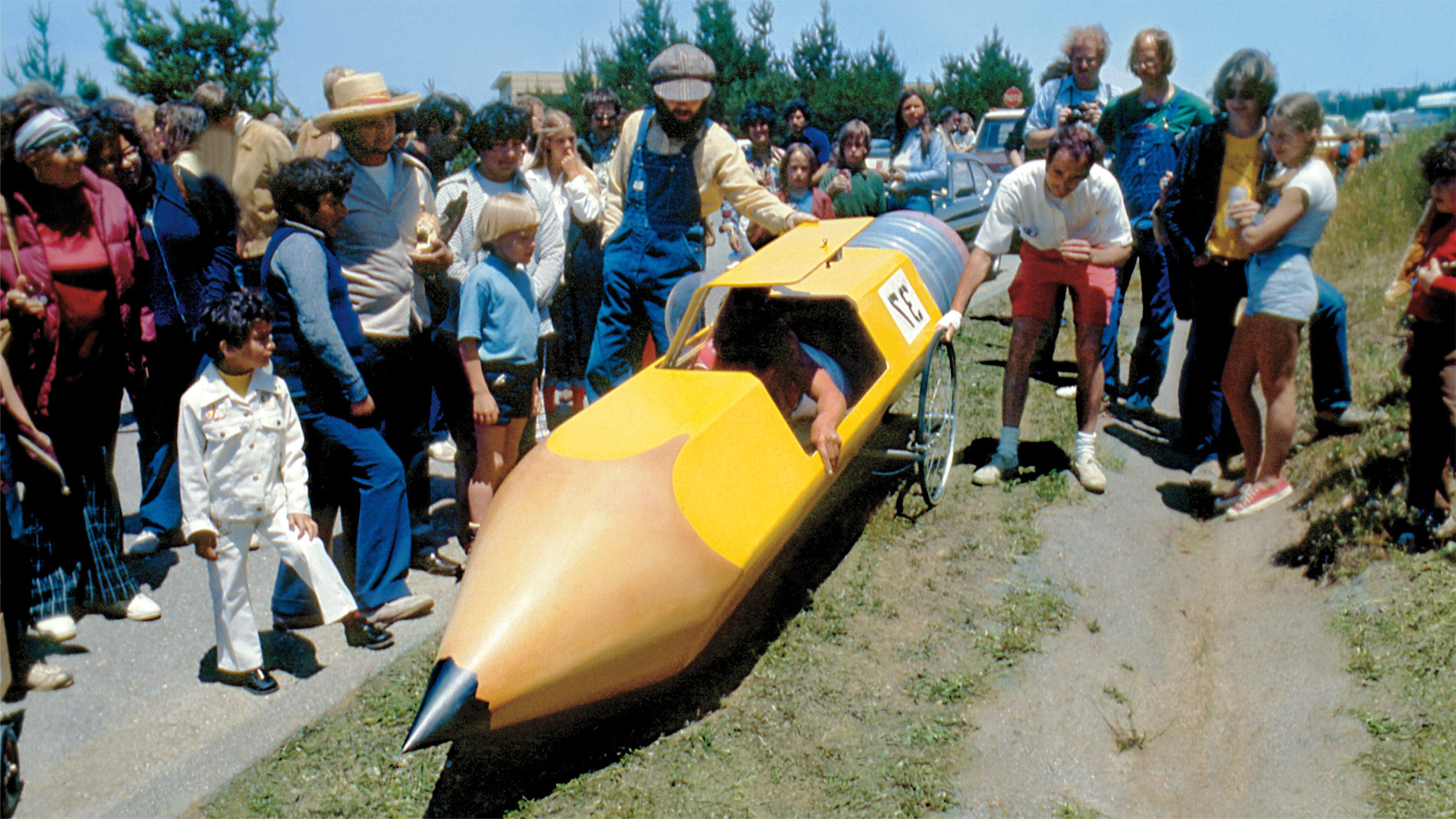
Richard Shaw, Tuxedo Racing Pencil, 1975 (The First Artists’ Soapbox Derby, May 18, 1975); SFMOMA Archives; photo: Rudy Bender
•••
